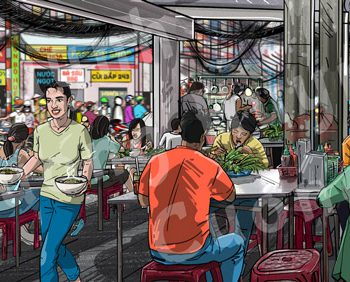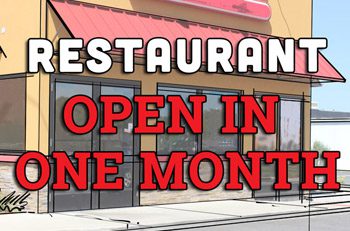This is Part 2 of a series on pho restaurant business plan. Read Part 1, Part 3 and Part 4.
Rather not do the business plan yourself? Then take advantage of my service to create a pho restaurant business plan for you.
Updated 02-18-19. In Pho Restaurant Business Plan, Part 1, I discussed what a pho restaurant business plan is and why an aspiring pho restaurateur needs one. In this post, I'll provide some guidelines to help you develop a solid pho restaurant business plan and pro forma yourself.
The point of all this business plan talk is to lay down the blueprint for you and your team to follow in building your new pho restaurant. But while it serves as the roadmap for you, it plays a much bigger role for your business.
If you are applying for a loan from a bank or have investors involved in funding your business, then a good business plan and pro forma are pretty much required. If you will have other people involved in carrying out the mission of your business, then a business plan and pro forma will help you stay on course to communicate to your team the company value, goals, visions, and track their performance in meeting those objectives.
So here we go.
 Company Profile
Company Profile
This is the place you start to create your company, or your restaurant.
Take some time to really create your company. By this I don’t mean filling out the paperwork and submitting for licenses, etc. Those are the easy stuff and you do them anyway.
I’m talking about taking the time to really think what your business is all about. Then describe it in words, including the value proposition you want to give customers, and the products and services you provide.
Additionally, you also want to write down your plan for management, location, legal structure of your restaurant. And last but not least, you should also define the vision, mission, goals and objectives that you envision for your business.
Market Research
Knowing the market is one of the most important aspects of successfully running a pho restaurant, or any restaurant for that matter.
You should write down what you understand to be your local market and all the dynamics that happen within it. This includes knowing your competitors (not just other pho restaurants but any other foodservice businesses that have paying customers similar to yours.) You should also want to understand your local market and demographics, know what your keys to success are, and clearly know your weak points.
To help with this process, you should perform a SWOT analysis. SWOT stands for Strengths, Weaknesses, Opportunities, Threats. In a nutshell, Strength and Weaknesses refer to your internal operation, things that you have control over. Once identified, you should discuss how you will use your strengths and mitigate weaknesses. Conversely, Opportunities and Threats are external to your business, and refer to things that are outside of your control. Once identified, you should find ways to take advantages of opportunities and deal with threats.
Once you've gone through it, you'll be amazed how the SWOT analysis can clearly show you how you can compete and make profits in the competitive foodservice business.
Sales and Marketing
Your pho restaurant business cannot survive without customers knowing about you or finding you.
This is the reason why you should allocate a strong effort to sales and marketing. Effort may include time or money or both. At the very least, you want to create your pricing strategy (e.g., how and why your menu items are priced); define your marketing strategy, activities and objectives; write a positioning statement to describe how you position your pho restaurant in the local market; and discuss the sales process to show you understand each and every sales step from acquiring a customer through getting paid by that same customer.
Lastly, despite being in a competitive market, no one ever operates in a vacuum. For this reason, you want to also discuss any alliance with other businesses or organizations to both parties’ mutual benefits.
Operations
This is the area that takes all your ideas, plans and projection and make them happen.
You want to show that you understand why you select/prefer a certain location for your pho restaurant; you understand the legal, risk/insurance and other business issues associated with running your business; you have a solid plan to solve your human resources issues; and you have at least thought about, if not figured out, the process and production steps to serve the items you have on your menu.
The process and production itself includes at least 3 very important components:
- The menu,
- The sale process and customer service, and
- Food preparation and production.
Spend sometime and plan out what you'll do in each area and how you'll do it. It's better to give some serious thoughts to these areas at this early stage, and then modify as you go, instead of later just making things up as you go.
Financials or Pro Forma
Almost all businesses are run by money and for money, and pho restaurants are no exception.
You can't hide from the numbers. You have to know your numbers, and the best time to learn your numbers is before you start. You want to spend some time understanding and making projection about your start-up costs, and then estimating your break-even points. Additionally, you want to make sales forecasts based on assumptions that can be updated over time, so that you’ll know all causes and effects that influence how your pho restaurant will perform. Typically, you want to do 3- or 5-year forecasts so that your cash flow situation is well understood.
Initial setting up of this system can be tedious, but once done, you'll have a template that can be used to assess multitude of business situations for your pho restaurant.
Putting It All Together
As you can see, both the business plan and pro forma serve as a critical tool to run your new pho restaurant successfully. They force you to look at all important aspects of your pho restaurant during the early stage of development, and to work out some solutions before you spend a dime on purchasing services and hardware. They will keep you on track with your restaurant development.
In Part 3 of this series, I’ll share the steps you can follow to create your own effective business plan and pro forma that will successfully communicate your pho restaurant concept, your visions, and the marketing and operation that support them.
For professional assistance with a business plan and pro forma, head over to the page Pho Restaurant Business Plan and book a FREE half-hour consultation to get started.
Also please leave your feedback in the comments below and let me know what you think.



